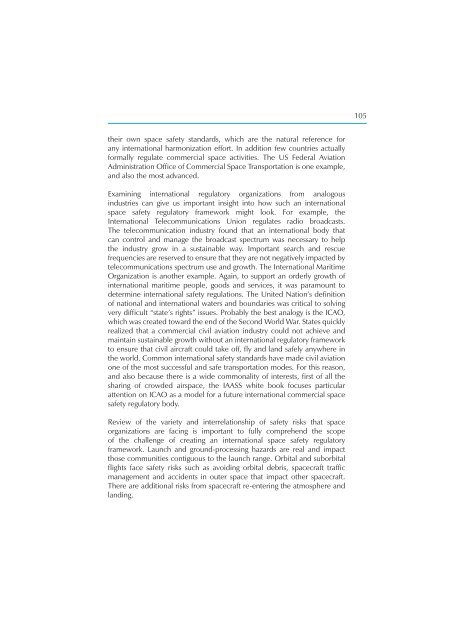Security in Space The Next Generation - UNIDIR
Security in Space The Next Generation - UNIDIR
Security in Space The Next Generation - UNIDIR
You also want an ePaper? Increase the reach of your titles
YUMPU automatically turns print PDFs into web optimized ePapers that Google loves.
their own space safety standards, which are the natural reference for<br />
any <strong>in</strong>ternational harmonization effort. In addition few countries actually<br />
formally regulate commercial space activities. <strong>The</strong> US Federal Aviation<br />
Adm<strong>in</strong>istration Offi ce of Commercial <strong>Space</strong> Transportation is one example,<br />
and also the most advanced.<br />
Exam<strong>in</strong><strong>in</strong>g <strong>in</strong>ternational regulatory organizations from analogous<br />
<strong>in</strong>dustries can give us important <strong>in</strong>sight <strong>in</strong>to how such an <strong>in</strong>ternational<br />
space safety regulatory framework might look. For example, the<br />
International Telecommunications Union regulates radio broadcasts.<br />
<strong>The</strong> telecommunication <strong>in</strong>dustry found that an <strong>in</strong>ternational body that<br />
can control and manage the broadcast spectrum was necessary to help<br />
the <strong>in</strong>dustry grow <strong>in</strong> a susta<strong>in</strong>able way. Important search and rescue<br />
frequencies are reserved to ensure that they are not negatively impacted by<br />
telecommunications spectrum use and growth. <strong>The</strong> International Maritime<br />
Organization is another example. Aga<strong>in</strong>, to support an orderly growth of<br />
<strong>in</strong>ternational maritime people, goods and services, it was paramount to<br />
determ<strong>in</strong>e <strong>in</strong>ternational safety regulations. <strong>The</strong> United Nation’s defi nition<br />
of national and <strong>in</strong>ternational waters and boundaries was critical to solv<strong>in</strong>g<br />
very diffi cult “state’s rights” issues. Probably the best analogy is the ICAO,<br />
which was created toward the end of the Second World War. States quickly<br />
realized that a commercial civil aviation <strong>in</strong>dustry could not achieve and<br />
ma<strong>in</strong>ta<strong>in</strong> susta<strong>in</strong>able growth without an <strong>in</strong>ternational regulatory framework<br />
to ensure that civil aircraft could take off, fl y and land safely anywhere <strong>in</strong><br />
the world. Common <strong>in</strong>ternational safety standards have made civil aviation<br />
one of the most successful and safe transportation modes. For this reason,<br />
and also because there is a wide commonality of <strong>in</strong>terests, fi rst of all the<br />
shar<strong>in</strong>g of crowded airspace, the IAASS white book focuses particular<br />
attention on ICAO as a model for a future <strong>in</strong>ternational commercial space<br />
safety regulatory body.<br />
Review of the variety and <strong>in</strong>terrelationship of safety risks that space<br />
organizations are fac<strong>in</strong>g is important to fully comprehend the scope<br />
of the challenge of creat<strong>in</strong>g an <strong>in</strong>ternational space safety regulatory<br />
framework. Launch and ground-process<strong>in</strong>g hazards are real and impact<br />
those communities contiguous to the launch range. Orbital and suborbital<br />
fl ights face safety risks such as avoid<strong>in</strong>g orbital debris, spacecraft traffi c<br />
management and accidents <strong>in</strong> outer space that impact other spacecraft.<br />
<strong>The</strong>re are additional risks from spacecraft re-enter<strong>in</strong>g the atmosphere and<br />
land<strong>in</strong>g.<br />
105








